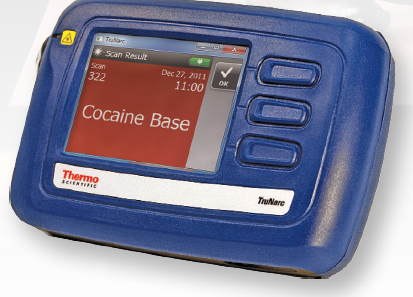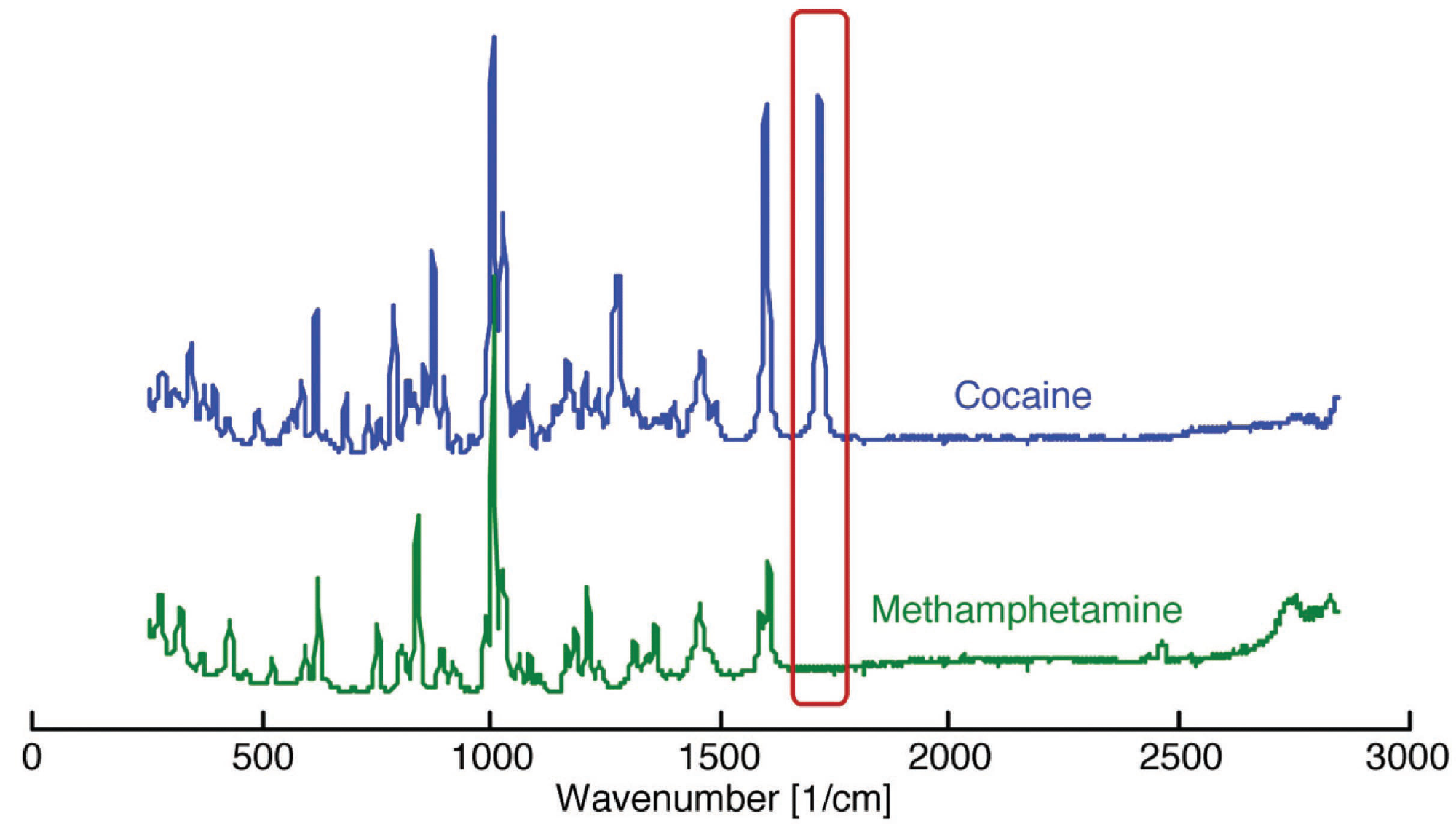The war on drugs shows no indication of slowing down; illicit drugs appear on the market every day, and law enforcement officers face numerous challenges in their endeavors to reduce trafficking and drug abuse.
From arrest to prosecution, the judicial process is long and expensive for taxpayers. After arrest, specific drug test kits are used to attain a positive indication for presumptive evidence, but for some newer or more exotic illicit drugs, such as synthetic cathinones or “bath salts,” test kits may not be available.
Seized drugs are sent to state laboratories for confirmation. As the laboratories are often overburdened, the process may be extended for weeks or even months before test results are returned to the prosecutor. The stress and burden placed on such labs to process samples as quickly as possible can be significant.
Fortunately, advanced analytical techniques for analysis (such as Raman spectroscopy) are beginning to be simplified and miniaturized for operation in the field. This transition allows users to conduct the same measurements at the point of interest, reducing burdens on crime labs and speeding up the process of prosecution.

Image Credit: Thermo Fisher Scientific – Portable and Handheld Raman Spectroscopy
This article outlines the solid technical foundation of Raman spectroscopy and introduces a new handheld Raman instrument designed for narcotics identification. By enabling narcotics identification in the field rather than in the laboratory, this technology facilitates swifter legal action and reduces costs.
Raman spectroscopy
Raman spectroscopy is a highly sensitive and established analytical technique for the analysis of gases, liquids, and solids. It is one of many techniques that are sensitive to the vibrations of atoms in molecules, classified as vibrational spectroscopy.
Although Raman spectroscopy was discovered in the 1920s, over the last four decades, we have seen a renaissance in the technique due to developments in more stable lasers, smaller components, and faster computers with associated search/match algorithms.
Infrared spectroscopy (IR) is another vibrational spectroscopy technique; both methods are often used in forensic laboratory settings due to their low false alarm rates and high specificity.
Raman spectroscopy, however, is sensitive to a material’s chemical structure and, therefore, can be used to identify a sample. Illicit drugs are organically based chemical compounds that vibrate at discrete frequencies.
The frequency and number of vibrations depend on the number of atoms in the compound and how the atoms are connected via specific chemical bonds. As these factors are different between any two chemical compounds, the vibrational frequencies will be different.
Raman spectroscopy utilizes such differences in a compound’s vibrational frequencies to differentiate compounds (see Figure 1).

Figure 1. Raman spectra for cocaine and methamphetamine. Image Credit: Thermo Fisher Scientific – Portable and Handheld Raman Spectroscopy
Field-based narcotics identification
Spectrometers (handheld field-based Raman instruments) are used for on-scene identification of hazardous chemicals and explosives. Such small and mobile equipment allows first responders to conduct assessments of potentially hazardous areas quickly and safely.
Handheld Raman systems have also been brought into field-based narcotics identification as a well-established forensic technique accepted by the Scientific Working Group for the analysis of seized drugs for the Analysis of illicit substances.
Forensic laboratories providing confirmatory narcotic testing results also use gas chromatography/mass spectrometry (GC/MS), which, despite giving definitive results, is an expensive technique confined to laboratories and is thus time-consuming, delaying reporting of results back to law enforcement agencies.
Track record
A number of civil actions, usually intellectual property cases relating to patent litigation in pharmaceuticals, have relied on Raman spectroscopy (see Abbott/Fournier Industrie v Teva, US District Court, Dist. of Delaware, Civ. No. 02-1512-KAJ; Takeda v Teva, US District Court, Dist. of Delaware, Civ. No. 06-033-SLR.; Abraxis Bioscience v Navinta, US District Court, Dist. of New Jersey, Civ. No. 07- 1251 (JAP)).
The technique meets the Daubert admissibility standards for admissibility in court, namely that:
- It is a technique with multiple uses in many fields, and it has been published in thousands of books, peer-reviewed journals, and treatises.
- It is well-understood, and the scientist who discovered it later won a Nobel Prize for his explanation of the method.
- There are established standards to assess the precision and accuracy of the technique. Such standards are available to the scientific community from nationally recognized standard-setting organizations.
- It has uses in the field as well as in laboratory settings.
- The reliability and relevance of the technique are reported and accepted by the scientific community, and it is authorized for use by US federal agencies.
Thermo Scientific TruNarc analyzers
The TruNarc analyzer is a field-based identification system that can identify numerous narcotics in seconds with a single test. The analyzer marries the chemical specificity of Raman with non-destructive, non-contact analysis, minimizing a law enforcement officer’s exposure to unknown materials and preserving the evidence.
Narcotic samples can be identified in their original packaging by pressing the sample to the nosecone of the analyzer and pressing the “scan” button. The device provides a definitive result with no user interpretation needed; all scans are time- and date-stamped and stored automatically.
The device’s interface allows an officer to transfer data to a computer for automated storage and reporting, includes a diagnostic system check to verify that it is working properly, and can support prosecution with permanent and printable records.
The Melendez-Diaz case
In US narcotics cases, as a consequence of the 2009 Supreme Court ruling on Luis E. Melendez-Diaz v. Massachusetts, attorneys representing defendants can subpoena any scientists that present lab test results on narcotics samples submitted into evidence.
This decision was a result of a 2001 cocaine trafficking case involving Melendez-Diaz. A local court ruled that the defendant’s Sixth Amendment rights (the right of a defendant to confront his accuser) were violated when a lab technician who identified a powder as cocaine did not testify in person.
During the 2001 trial, the defense attorney objected to the evidence (based on the Sixth Amendment), but his objection was overruled. Melendez-Diaz was found guilty and was eventually convicted, but later appealed his case to the Supreme Court, which in 2009 reversed the original court ruling.
Thus, a new precedent was set; defense attorneys can request testimony from a scientist who completes narcotics testing and use it as evidence in a prosecution. This decision has had a huge impact on these scientists, adding courtroom testimony to their workload.
Shifting narcotics identification from the laboratory to the field could reduce backlogs and create a quicker, more streamlined prosecution process for narcotics cases.
Lab versus field results
Street samples of heroin, cocaine, and methamphetamine analyzed by the TruNarc system were compared with laboratory tests for the same samples; 131 of the 137 samples analyzed by the TruNarc device agreed with the lab result.
The remaining results allowed researchers to inform subsequent analysis and correctly identify cutting agents. There were no false positive results.
For more information, refer to “Improvements in Field Narcotics Identification Using Raman Spectroscopy: A Comparison of Raman Field Test Results and Laboratory Test Results,” White Paper 201b.
Conclusion
Although there is variation in different areas, processes of adjudicating drug-related arrests are similar across the US. Despite increases in trafficking narcotics, pressures around expenditure force jurisdictions to evaluate which drug cases they prosecute and which drugs are sent to labs for analysis.
There was a substantial movement to reduce lab testing for DUI arrests in the 1970s, resulting in the acceptance of field confirmatory alcohol content testing; narcotics testing is following a similar route.
The ability of defense attorneys to require narcotics-testing scientists to testify in court has had a costly effect on the judicial process of prosecuting drug users and dealers. Relieving this pressure could directly impact the costs associated with using laboratories for drug testing.
As well as reducing backlogs in laboratories, the TruNarc analyzer may have other benefits for law enforcement agencies, such as use as a screening tool for sample submissions to a laboratory, where labs could, therefore, sample a smaller amount of submissions for confirmatory testing.
The analyzer could also be utilized for field confirmatory identification for possession cases, allowing labs to focus on trafficking cases or samples that cannot be analyzed in the field.
The TruNarc system provides definitive and clear results and automated, comprehensive reports for each analysis. It collects detailed spectral data, which can be submitted for further analysis or compared to library standards if necessary.
With such a device, law enforcement officers can reliably identify suspected narcotics at the point of seizure.
Acknowledgments
Produced from materials originally authored by David Bugay from PharmAnalysis and Michael Cipoletti of Waynesburg University.
About Thermo Fisher Scientific – Portable and Handheld Raman Spectroscopy
Thermo Fisher Scientific offers innovative solutions that help our customers solve complex analytical challenges, accelerate life sciences manufacturing, deliver medicines to market, and increase laboratory productivity. Our Thermo Scientific portable and handheld process Raman analyzers enable accurate, real-time results for process monitoring.
The Thermo Scientific™ MarqMetrix™ All-In-One Process Raman Analyzer is an all-in-one system purpose-built for rapid deployment, ease of use, and scalability in markets where time-to-results is critical. The MarqMetrix All-In-One Process Raman Analyzer is designed for:
- Analysis without sample preparation, delivering Raman spectral results in real-time
- Easy setup and deployment by non–Raman spectroscopists
- Non-destructive workflows to protect precious samples
- Non-invasive handling to minimize contamination of samples
- Small footprint for convenient deployment
- Factory calibration for hardware stability and portability
Our Thermo Scientific TruScan™ Handheld Raman Analyzers includes state-of-the-art optics paired with a patented multivariate residual analysis that offers an effective chemometric solution for material identification, with two spectral pre-processing options. The non-destructive point-and-shoot sampling principle facilitates rapid verification of a broad range of chemical compounds, including cellulose-based products.
The TruScan™ G3 Handheld Raman Analyzer continues the evolution of raw material ID testing for pharmaceutical and biotechnology manufacturing quality control processes with:
- Incoming raw material identification (RMID)
- Dispensing of materials during API manufacture
- Finished product inspection
- Identification of falsified (counterfeit) medicines
- Enables non-technical operators to rapidly perform raw material ID testing without the need of a lab
The TruScan™ RM Handheld Raman Analyzer takes pharmaceutical manufacturing QA/QC to the next level with:
- Enhanced 21 CFR Part 11 and cGMP compliance with biometric login, complex password options, and full audit trail features
- Non-contact analysis through plastic bags, glass containers, blister packs and clear gel caps
- Intuitive workflow adapted to production environment through PDF batch reports and ease of data input using barcode scanners
- Easy fleet management feature that enables cloning of instruments and identification methods
Sponsored Content Policy: News-Medical.net publishes articles and related content that may be derived from sources where we have existing commercial relationships, provided such content adds value to the core editorial ethos of News-Medical.Net which is to educate and inform site visitors interested in medical research, science, medical devices and treatments.